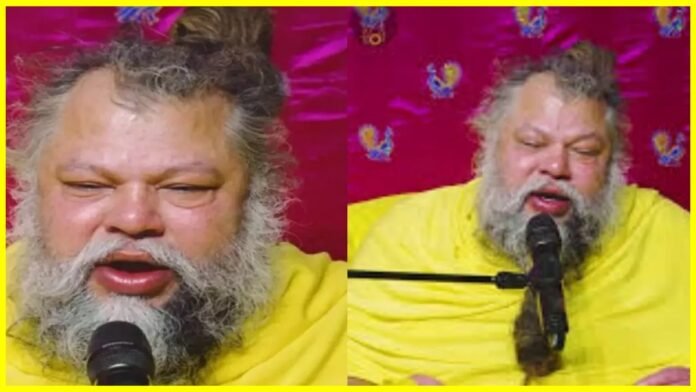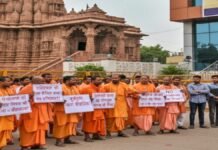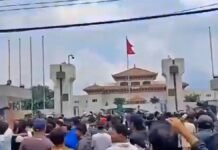
Key Points
- False rumors of Premanand Maharaj’s death spread rapidly across Facebook and Instagram on October 8-9, 2025
- Mathura Police intervened through official X (Twitter) handle, confirming spiritual leader is “completely healthy”
- Police warned of legal action against those spreading “false and baseless rumors”
- Facebook user Sunil Pandit posted initial death claim, later edited post and apologized after police intervention
- Premanand Maharaj himself released video clarification on Wednesday, October 9, 2025
- Saint attributed false rumors to influence of “Kali Yuga” during three-day private spiritual discussion
- Incident highlights growing problem of unverified death hoaxes targeting religious figures on social media
- Devotees expressed emotional distress before clarification emerged
Mathura: A false rumor claiming the death of prominent spiritual leader Premanand Maharaj spread like wildfire across social media platforms on October 8-9, 2025, causing widespread panic and emotional distress among his millions of devotees before being swiftly debunked by Mathura Police and the saint himself. The incident represents another alarming example of how unverified information can rapidly circulate on social media, creating unnecessary confusion and anxiety.
The rumor originated when a Facebook user identified as Sunil Pandit posted a message declaring, “Extremely sad that Premanand Maharaj Ji has passed away.” This single post triggered an avalanche of shares, comments, and reactions across Facebook, Instagram, and other social media platforms, with devotees expressing grief and seeking confirmation of the shocking news.
Rapid Spread Across Social Media Platforms
Within hours of the initial Facebook post, the alleged death news had spread exponentially across multiple social media platforms. Thousands of followers of Premanand Maharaj—a revered spiritual leader with a massive following across India—began sharing the information, creating a viral chain reaction that amplified the false claim.
The rumor gained particularly strong traction on Instagram and Facebook, where religious and spiritual content enjoys significant engagement. Devotees who had been following Premanand Maharaj’s teachings for years responded with emotional tributes, condolence messages, and prayers, genuinely believing their spiritual guide had passed away.
As the news continued spreading, confusion mounted. Users began questioning the authenticity of the reports, with some demanding official confirmation before accepting the information. A user identified as @annushreex on social media captured this uncertainty, posting: “Is the news about Premanand Maharaj Ji true?” This question reflected the growing skepticism among more cautious followers who recognized the lack of credible sources for the death claim.
Simultaneously, several social media users who had direct connections to Premanand Maharaj’s ashram or organization began posting counter-information, stating that the reports were false and that the spiritual leader was alive and well. However, these corrective posts initially struggled to achieve the same viral reach as the original false claim, highlighting a common problem in digital misinformation where sensational false news often spreads faster than factual corrections.
Mathura Police Intervention and Official Clarification
Recognizing the seriousness of the situation and the distress being caused to lakhs of devotees, Mathura Police took swift action on October 9, 2025. The police department issued an official statement through their verified X (formerly Twitter) handle, directly addressing and refuting the death rumors.
The police statement read: “It is to inform you that the most revered Saint Premanand Maharaj Ji is completely healthy.” This clear, authoritative declaration from an official law enforcement agency carried significant weight in countering the misinformation that had been circulating.
Beyond merely clarifying the facts, Mathura Police also issued a stern warning to those responsible for spreading the false information. The police added in their post: “Please refrain from spreading false and baseless rumors, or legal action will be taken against you.” This warning signaled that authorities view the spread of such misinformation seriously, particularly when it causes public distress and potentially violates laws related to spreading false information.
The legal framework in India includes provisions under the Information Technology Act, 2000, and Indian Penal Code sections that address the creation and dissemination of false information intended to cause public mischief, hurt religious sentiments, or create panic. The police warning indicated potential application of these legal provisions against rumor-mongers.
Original Poster Apologizes
Following the police intervention and official clarification, Sunil Pandit—the Facebook user who had posted the initial death claim—took corrective action. He edited his original Facebook post and issued an apology for spreading unverified information without confirming its authenticity.
This sequence of events demonstrates both the problem and a potential solution: while social media platforms enable rapid spread of misinformation, swift official intervention combined with social pressure can lead to retractions and apologies from those who initiated false claims.
The incident also raises questions about individual responsibility in the digital age. Social media users increasingly share information without verification, driven by the desire for engagement, attention, or simply assuming others have verified the facts. The consequences, as seen in this case, can be significant emotional distress for thousands of people.
Premanand Maharaj’s Personal Clarification
Adding another layer of reassurance for concerned devotees, Premanand Maharaj himself addressed the false rumors on Wednesday, October 9, 2025. The spiritual leader posted a video message on his official social media account associated with “Bhajan Marg”—his spiritual organization and platform.
In the video clarification, Premanand Maharaj explained that he had been engaged in private spiritual discussions for the previous three days, which may have contributed to reduced public visibility and created an information vacuum that allowed rumors to flourish. This absence from public view likely made devotees more susceptible to believing unfounded death claims.
Addressing the phenomenon of false rumors from a spiritual perspective, Premanand Maharaj attributed the spread of lies and misinformation to the influence of “Kali Yuga”—a concept in Hindu philosophy referring to the current age characterized by moral decline, spiritual darkness, and prevalence of falsehood. This framing aligned with his spiritual teachings while also serving as a gentle rebuke to those who had spread or believed the rumors without verification.
The saint’s personal appearance in a video provided the most compelling evidence of his well-being, effectively ending any remaining doubts among his followers. Video evidence carries particular weight in countering death hoaxes, as it provides visual, real-time proof that contradicts false claims.
Pattern of Celebrity Death Hoaxes
The Premanand Maharaj incident fits within a broader pattern of celebrity and religious figure death hoaxes that have become increasingly common in the social media era. Spiritual leaders, film stars, politicians, and other public figures regularly become targets of false death rumors, often with no clear motive beyond generating engagement or causing disruption.
Several factors contribute to the persistence of such hoaxes:
Information Asymmetry: Public figures may have periods of reduced visibility, creating uncertainty that rumor-mongers exploit
Emotional Engagement: Death announcements trigger strong emotional responses, leading to rapid sharing before verification
Platform Algorithms: Social media algorithms often amplify sensational content, giving false claims disproportionate reach
Verification Challenges: Average users lack easy methods to verify information about public figures’ current status
Malicious Intent: Some perpetrators deliberately spread false information to create panic, damage reputations, or achieve other objectives
Legal and Social Implications
The Mathura Police warning about legal action highlights growing recognition among authorities that social media misinformation cannot be dismissed as harmless. False death rumors can have serious consequences:
Emotional Distress: Devotees, family members, and followers experience genuine grief and anxiety based on false information
Reputational Harm: Repeated death hoaxes can damage the dignity and reputation of the targeted individual
Public Order: Large-scale false rumors can trigger gatherings, protests, or other public responses that strain law enforcement resources
Erosion of Trust: Frequent hoaxes undermine public confidence in information sources and make people skeptical of legitimate news
Legal provisions that may apply to such cases include:
- Section 505 of the Indian Penal Code (statements conducing to public mischief)
- Section 66D of the IT Act (punishment for cheating by personation using computer resource)
- Provisions related to defamation and causing hurt to religious sentiments
Responsibility of Social Media Platforms
The incident also raises questions about the responsibility of social media platforms like Facebook and Instagram in preventing the spread of false death claims. While platforms have implemented fact-checking mechanisms and warning labels for certain types of misinformation, death hoaxes often spread too quickly for these systems to intervene effectively.
Potential platform-level solutions could include:
Verified Accounts: Ensuring authentic accounts for public figures make status updates easily accessible
Rapid Response Systems: Mechanisms allowing official representatives to quickly flag and counter false death claims
Source Credibility Indicators: Warning users when sharing information from unverified or low-credibility sources
Friction in Sharing: Introducing brief delays or prompts encouraging verification before sharing sensitive information about deaths
Lessons and Preventive Measures
For devotees and social media users, this incident offers several important lessons:
Verify Before Sharing: Always check official sources or credible news outlets before sharing sensitive information
Look for Official Statements: Religious organizations, ashrams, and public figures typically have official communication channels for important announcements
Be Skeptical of Shocking Claims: Extraordinary claims require extraordinary evidence; death announcements should come from authoritative sources
Consider Consequences: Recognize that sharing false information, even unintentionally, can cause real harm to real people
Wait for Confirmation: When in doubt, wait for official confirmation rather than contributing to rumor spread
The swift resolution of this particular hoax—thanks to police intervention and Premanand Maharaj’s personal clarification—represents a best-case scenario. However, not all such incidents resolve so quickly or clearly, making prevention through user awareness and platform responsibility increasingly important.
As Premanand Maharaj continues his spiritual work in good health, this episode serves as a cautionary tale about the power and dangers of social media misinformation in an era where false claims can reach millions within hours.




















































